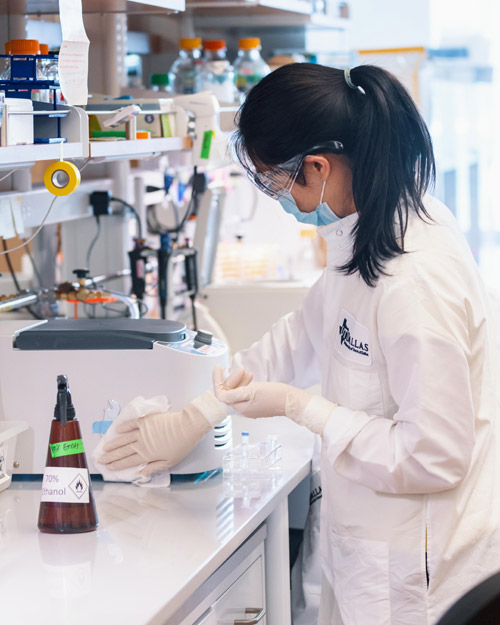Nearly every aspect of society has had to adapt to ever-changing conditions brought on by the global COVID-19 pandemic, and scientific research is no exception.
The University of Texas at Dallas is among 131 U.S. colleges and universities that are recognized by the Carnegie Classification of Institutions of Higher Education as R1 doctoral institutions, which are characterized by “very high research activity.” Like most top-tier research institutions, UT Dallas ratcheted down its on-campus research operations to a maintenance-only mode in March as shelter-in-place orders took effect in Texas and the campus emptied of all but essential personnel. Safety, maintenance and environmental teams, as well as the staff of the Lab Animal Resource Center, continued operations on-site.
“As our research operations have transitioned from ‘maintenance-only mode’ to resuming limited research activity, the health and safety of our students, faculty and staff has been our No. 1 priority,” said Dr. Joseph Pancrazio, vice president for research and a professor of bioengineering at UT Dallas. “The Office of Research has been fully engaged with faculty stakeholders to create a framework for a successful return to research. This has been a great opportunity to focus on other phases of research, such as analyzing data and writing grant proposals, which often take a back seat to collecting data in the lab.”
Videoconferencing tools have allowed faculty members to continue to meet regularly with their graduate students and other lab members, as well as out-of-town collaborators.
“It was critical that we meet the needs of essential research and be flexible, while also maintaining the health and safety of individuals. For example, our reservation system helps ensure research labs are not overcrowded at any point in time and further allows for appropriate sanitation efforts in between research activities.”
Kathan McCallister, assistant vice president for research operations
At the time of the shutdown, only essential research — including COVID-19-related work — was allowed to take place on campus. A review board of faculty and safety personnel evaluated each request for campus access.
In late May, research operations transitioned from maintenance-only to the resumption of limited research activities, a phase that allows up to 25% of researchers to be on campus at any one time.
To make that transition, Office of Research administration worked closely with faculty to develop a robust set of tools, including safety protocols and training. For example, investigators returning to campus are able to request access for themselves and members of their research group. Those elected individuals are then tasked with completing online training modules and submitting electronic health-status assessments for each day they are on campus before reserving specific time to be in the lab.

Kathan McCallister, assistant vice president for research operations, said providing the infrastructure, protocols and support for a limited return of research to campus was “a very well-thought-out process based on familiarity with the needs of our research faculty and the tools already available to us.”
“It was critical that we meet the needs of essential research and be flexible, while also maintaining the health and safety of individuals,” McCallister said. “For example, our reservation system helps ensure research labs are not overcrowded at any point in time and further allows for appropriate sanitation efforts in between research activities.”
R. Gabe Cavazos, senior director of research information systems, and his team were instrumental in adapting data-collection software already in use by the Office of Research to a system that combines scheduling, health assessments and other variables. That system is now being used campuswide as more staff and faculty begin to return in preparation for the fall semester.
“When it comes to their research activities, we took the same approach as our faculty — you don’t just put down your tools and wait it out,” Cavazos said. “You find new tools; you sharpen the ones you have; you find new methodologies to enable work.”
Sanaz Okhovat, associate vice president for research and chief compliance officer for the University, said faculty feedback and buy-in has been crucial to the success of the processes that have been put in place.
“The Office of Research response to the COVID-19 pandemic has been geared to protecting our faculty, students, staff and the larger community. UT Dallas’ commitment to a culture of safety easily created a platform to institute our phased approach to resume critical research activities,” Okhovat said. “I commend our faculty’s engagement in developing and implementing these processes at a rapid pace.
“The invaluable support of President Richard Benson, Provost Inga Musselman and Chief of Staff Rafael Martín was critical to safely resuming research activities. We will continue to prioritize the welfare of our UT Dallas community and support research, as it is essential to the University’s mission.”